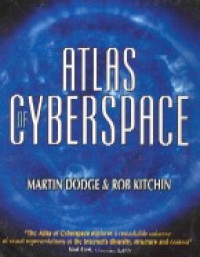
Atlas of Cyberspace
| Gmd : Text
| Availability :
| 00000008193 | TK5105.875 .I57D63 2001 REF | (Reference) | Available - Ada |
Amazon.com
We don't normally consider maps contentious, but the Atlas of Cyberspace makes us think otherwise. Information cartographers Martin Dodge and Rob Kitchin show off a wide range of possibilities in representing the vast realms of data existing on and supporting the Internet. Since so many of these models were created to display never-before-charted territories, the book is largely devoted to analyzing their accuracy, ease of development and use, potential for abuse, and other qualities.
Chapters cover infrastructural elements, the Web, communities, and creative renderings of cyberspace, and contain both compelling images and thought-provoking texts. Though it ends up feeling more like a catalog of visual display methods than a reference book detailing virtual geography, its examples still inform and startle the viewer with unexpected transformations of data into understanding, and, occasionally, art. --Rob Lightner
From Book News, Inc.
The fledgling field of cybergeography seeks to provide a visual "big picture" of the shape-shifting entity that is the Internet, giving people a sense of space that is difficult to grasp by navigation alone. Dodge (University College, London) and Kitchin (National U. of Ireland), who also wrote Mapping cyberspace, spent five years collating maps and research papers and interviewing the maps' creators to produce this first, comprehensive guide to the visual representation of cyberspace media. A book that is beautiful as well as densely packed with information, it covers facets of the Net from the history of telecommunications to Web sites, e-mail, virtual worlds, and game space. Wide format: 10.25x10.Book News, Inc.?, Portland, OR
Book Info
Explores the new cartographic and visualization techniques being employed in the mapping of cyberspace, concentrating on the areas of; Internet infrastructure and traffic flows, the World Wide Web, Online conversation and community, and Imaging cyberspace in art, literature and film.
About the Author
Martin Dodge works as a computer technician and researcher in the Centre for Advanced Spatial Analysis (CASA), at University College London. He maintains the Cyber-Geography Research web site at cybergeography, which includes the original online Atlas of Cyberspaces. With co-author Rob Kitchin, he also wrote the book Mapping Cyberspace (2000).
Rob Kitchin is a Lecturer in Human Geography and research associate of NIRSA at the National University of Ireland, Maynooth. He is the author of Cyberspace (1998) and the co-author of Mapping Cyberspace (2000). He has published three other books and is the general editor of the journal Social and Cultural Geography. 0201745755AB07172001
Excerpted from Atlas of Cyberspace by Martin Dodge, Rob Kitchin. Copyright ? 2001. Reprinted by permission. All rights reserved.
It is now over 30 years since the first Internet connection was made, between nodes installed at UCLA and Stanford University in the United States. Since then, a vast network of information and communications infrastructure has encircled the globe supporting a variety of cyberspace media ? email, chat, the Web, and virtual worlds. Such has been the rapid growth of these new communications methods that by the end of 2000 there were over 400 million users connected to the Internet.
Accompanying this growth in the infrastructure, the numbers of users and the available media has been the formation of a new focus for cartography: mapping cyberspace. Maps have been created for all kinds of purposes, but the principal reasons are: to document where infrastructure is located; to market services; to manage Internet resources more effectively; to aid searching, browsing and navigating on the Web; and to explore potential new interfaces to different cyberspace media. In creating these maps, cartographers have used innovative techniques that open up new ways to understand the world around us.
This is the first book to draw together the wide range of maps produced over the last 30 years or so to provide a comprehensive atlas of cyberspace and the infrastructure that supports it. Over the next 300 or so pages, more than 100 different mapping projects are detailed, accompanied by full-colour example maps and an explanation as to how they were created.
| Series Title |
-
|
|---|---|
| Call Number |
TK5105.875 .I57D63 2001 REF
|
| Publisher Place | Harlow |
| Collation |
xi, 268p.: ill.; 25cm.
|
| Language |
English
|
| ISBN/ISSN |
0201745755
|
| Classification |
TK
|
| Media Type |
-
|
|---|---|
| Carrier Type |
-
|
| Edition |
-
|
| Subject(s) | |
| Specific Info |
-
|
| Statement |
-
|
| Content Type |
-
|
No other version available







